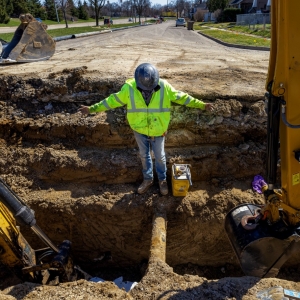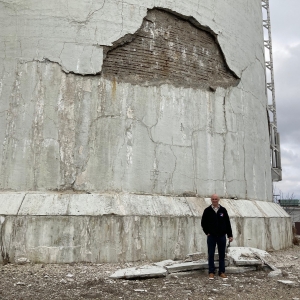This week’s episode of What’s Up With Water covers two UN reports on humankind’s impact on Earth’s lands and waters, worsening food crises in the Horn of Africa, and Las Vegas’s water insurance policy. Plus, Circle of Blue reports on Michigan’s opportunity to correct decades of water mismanagement.
Transcript
Welcome to “What’s Up With Water” – your need-to-know news of the world’s water from Circle of Blue. I’m Eileen Wray-McCann.
Last week, United Nations agencies reported on humankind’s extensive impact on lands and waters, and how societies can respond to those changes. A report from the UN Convention to Combat Desertification says that 40 percent of the Earth’s land surfaces have been impaired, largely due to commercial agriculture. Growing food and fiber is responsible for 80 percent of tree cutting and 70 percent of water use, as well as the majority of biodiversity loss. The report argues that It doesn’t have to be this way. For food systems and other land uses, restoring and protecting ecosystems is a requirement for sustainable livelihoods. If current trends continue, the report estimates that within three decades an area the size of South America will further degrade. But in a restoration scenario, that degradation is reversed. Healthier soils mean more carbon storage, more retention of rainwater, and higher crop yields.
A second report is from the UN Office for Disaster Risk Reduction, an agency focusing on how severe weather and other natural hazards affect society. The report found that those risks are being magnified. A warming planet is increasing the number of droughts and heat waves. The countries most vulnerable to these disasters are among the world’s poorest places. The report criticizes global governance and financing systems for not funding work that is key to building resilience to natural hazards. Only a small fraction of foreign assistance budgets are dedicated to this work.
The vulnerability of the poorest is starkly evident in the Horn of Africa, where a severe drought and rising global food prices are spurring a hunger crisis. According to UNICEF, at least 10 million children in Ethiopia, Kenya, and Somalia face hunger, malnutrition, or thirst. That is a 40 percent increase since the agency’s assessment in January. The region is suffering from multiple shocks. Crops and livestock herds have been decimated by three weak rainy seasons in a row. Adding to the stress, global food prices have soared in the wake of Russia’s invasion of Ukraine. Analysts fear that a fourth failed rainy season is now underway. If rains do not pick up by June, UNICEF warns that many more children in the region will not get enough to eat.
In the United States, meanwhile, the water emergency on the Colorado River reached a symbolic milestone last week. Lake Mead dropped low enough to expose the top of one of the drinking water intakes for Las Vegas. Las Vegas has three pipes that draw water from different elevations in Lake Mead. Even when the reservoir drops below the first intake pipe, Las Vegas still has two pipes at lower depths that it can rely on. The Southern Nevada Water Authority, the regional water supplier, built an intake at the bottom of the reservoir. It was completed in 2015, and cost $817 million. The project was an insurance policy against Lake Mead’s further decline. Last week, the policy started to pay off, when for the first time, the water authority activated the pumping station for the bottom intake. A federal forecast expects that Lake Mead will continue to decline this year.
This week, Circle of Blue reports on Michigan’s positioning for an infrastructure comeback.
Six years ago a panel of experts convened by former Gov. Rick Snyder concluded that Michigan’s public works — its roads, sewers, water distribution pipes, and other vital systems — were in “a state of disrepair.” The panel’s report noted that Michigan once set the standard for industrial development and economic opportunity in the 20th century. These days, it argued, the state is falling behind in a globalized economy by not investing in basic connective assets like potable water and wastewater treatment. The report came at a low point in Michigan’s public works history: a year after revelations of the extent of mismanagement of Flint’s drinking water system.
Since the report’s publication, though, Michigan appears to be positioning itself on the cusp of renewal. The quality of the state’s water infrastructure and the consequences of failure, while still real and apparent, are no longer being ignored. In large part that’s because of a rare spirit of bipartisanship around water-related policy in Michigan and the country. The roughly $50 billion for water and sewer systems in the Infrastructure Investment and Jobs Act, signed into law by President Biden last November, will be the largest federal infusion of money into the sector in a half century, ever since the Clean Water Act led to construction grants for modern sewage treatment.
In March, Gov. Gretchen Whitmer and the state Legislature negotiated and passed a $4.7 billion infrastructure package, allocating federal funds from the American Rescue Plan Act and the Infrastructure Investment and Jobs Act. The package contained more than $1 billion for drinking water improvements and $712 million for sewer, stormwater, and septic system repairs. The drinking water allotment includes $325 million to replace lead service lines. Many in the water sector see the federal infrastructure bill as a once-in-a-career opportunity to make up for underinvestment and a chance to tackle long-standing problems.
The costs are enormous and success will depend on how well these upgraded assets are maintained over the years. But for the first time in decades Michigan is taking on systemic water challenges that local and state officials and taxpaying residents have been unable to resolve – addressing fundamental issues like delivering drinking water and cleaning up wastewater. There is potential in an alignment of efforts to reverse Michigan’s infrastructure decline:
- At the direction of the state, utilities are reviewing their assets and developing management strategies to reduce costs.
- Communities are creating programs to help make water affordable and are lobbying for state and federal funding to augment them.
- Regional bodies are working to coordinate investments and collaborate across political jurisdictions.
- Michigan’s goal of removing all lead service lines by 2045 is meeting with some success. With $350 million in state funding and $100 million in federal funding, 90 percent of Flint’s lead lines have been replaced. In addition, the state has allocated about $63 million to replace lead lines and address other infrastructure needs in Benton Harbor.
These points of progress for water infrastructure in Michigan are vulnerable to financial and regulatory shortcomings:
- The federal infrastructure bill is far too small to respond to all needs. There is already evidence that Michigan households with low incomes are stressed by high water costs.
- Many rural water districts rely on distribution systems that have not been updated for decades, due to lack of money or political will.
- Playing catch-up after all these years will be costly. Even though water bills are rising fast, revenues are still not enough to keep pace with long-term operation, maintenance, and capital costs.
- Moreover, the state lacks a centralized source of information about system size, water production and rates. In fact, Michigan lacks virtually any authority to oversee the financial health of its water systems.
- Michigan has no comprehensive plan for managing an estimated 300,000 failing septic systems that are polluting the state’s lakes, streams, and groundwater.
Functioning water and sewer systems are a collaborative venture between federal, state, and local agencies and the people they serve. Provisioned with the materials for change, agencies and communities have the chance to rebuild this essential infrastructure by putting the pieces in their proper place.
And that’s “What’s Up With Water” from Circle of Blue, where water speaks. More water news and analysis await you at circleofblue.org. I’m Eileen Wray-McCann – thanks for being here.
Eileen Wray-McCann is a writer, director and narrator who co-founded Circle of Blue. During her 13 years at Interlochen Public Radio, a National Public Radio affiliate in Northern Michigan, Eileen produced and hosted regional and national programming. She’s won Telly Awards for her scriptwriting and documentary work, and her work with Circle of Blue follows many years of independent multimedia journalistic projects and a life-long love of the Great Lakes. She holds a BA and MA radio and television from the University of Detroit. Eileen is currently moonlighting as an audio archivist and enjoys traveling through time via sound.





